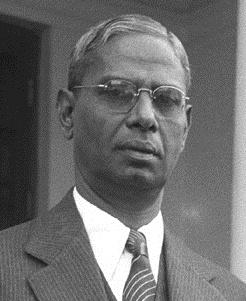
Sir Ramasamy Chetty Kandasamy Shanmukham ChettyKCIE was an Indian lawyer, economist and politician who served as independent India's first finance minister from 1947 to 1949. He also served as President of India's Central Legislative Assembly from 1933 to 1935 and Diwan of Cochin kingdom from 1935 to 1941.
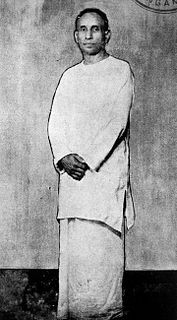
Ikkanda Warrier (1890–1977) was the first and the last Prime Minister of the state of Cochin, India, beginning in 1948.
Diwan Bahadur Lakshminarayanapuram Krishna Ananthakrishna Iyer (1861–1937) was an anthropologist of British India, who is renowned for his work amongst the hill tribes of the western part of Madras province.

Sir Kumarapuram Seshadri Iyer,, or Sheshadri Aiyar was an advocate who served as the Dewan of Mysore from 1883 to 1901. He was the second Dewan of Mysore state since the reinstatement of the Wodeyar family on its throne in 1881 and was the longest serving Dewan of the princely state as well. He is regarded by most as the "Maker of Modern Bangalore".
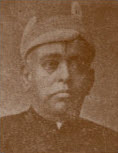
Diwan Bahadur Sir Perungavur Rajagopalachari, KCSI, CIE, also spelt in contemporary records as Sir P. Rajagopala Achariyar, was an Indian administrator. He was the Diwan of Cochin State from December 1896 to August 1901 and of Travancore from 1906 to 1914.

S. Shungrasoobyer (1836–1904), also known as Sankara Subha Iyer, was an Indian administrator who served as the Diwan of Travancore State from 1892 to 1898.
Diwan Bahadur Cozhisseri Karunakara Menon (1863–1922) was an Indian journalist and politician from the erstwhile Madras Presidency. He was the second editor of The Hindu after G. Subramania Iyer and the founder of the Indian Patriot.
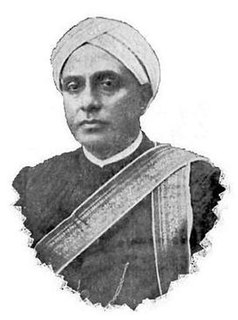
Diwan Bahadur V. S. Subrahmanya Iyer was an Indian administrator who served as the Diwan of the princely state of Travancore from 1929 to 1932.
Diwan Bahadur Sesha Iyengar Srinivasa Raghavaiyangar was an Indian civil servant and administrator who served as the Diwan of Baroda from 15 July 1896 to 2 October 1901. He was the elder brother of Indian journalist, Kasturi Ranga Iyengar.
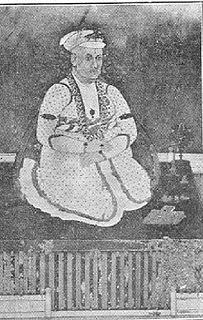
Rai Raya Rai Venkata Rao, was an Indian administrator and statesman who served as Diwan of Travancore 1821–1829 and 1838–39. He was the father of R. Raghunatha Rao and paternal uncle of Sir T. Madhava Rao.
Venkata Rayar was an Indian administrator who served as the Diwan of Cochin kingdom from 1856 to 1860. He became Diwan in 1856 on the sudden death of the then Diwan, T. Sankara Warrier. He was highly unpopular for his repressive policies. Eventually, delegation of popular citizens from Cochin met the Governor of Madras and submitted a memorandum requesting his removal. On the orders of the Governor of Madras, the then king of Cochin removed Venkata Rayar and replaced him with T. Sankunni Menon.
Sir Albion Rajkumar BanerjeeCSI CIE was an Indian civil servant and administrator who served as the Diwan of Cochin from 1907 to 1914, Diwan of Mysore kingdom from 1922 to 1926 and as Prime Minister of Kashmir from 1927 to 1929.
Diwan Bahadur Sir Thiruvalayangudi VijayaraghavacharyaKBE was an Indian civil servant and administrator who served as the Diwan of Cochin kingdom from 1919 to 1922. Vijayaraghavacharya was also a member of the Constituent Assembly of India representing Udaipur.
Diwan Bahadur Cherubala Pathayapura Karunakara Menon (1891–1976) was an Indian civil servant and administrator who served as the Diwan of Cochin kingdom from 1944 to 1947. He was the last Diwan of the kingdom and served till its accession to the Indian Union.
Diwan Bahadur Nemali Pattabhirama Rao Pantulu was an Indian civil servant and administrator who served as the Diwan of Cochin kingdom from 1902 to 1907.
P. Narayana Menon was an Indian lawyer, politician and administrator who served as the diwan of the Cochin kingdom from 1922 to 1925.
Diwan Bahadur Thodla RaghavaiahCSI was an Indian administrator who served as the Diwan of Travancore from 1920 to 1925. He was a favourite of the Maharaja Moolam Thirunal. His refusal to allow low-caste to enter Hindu temples is believed to have led to the Vaikom Satyagraha.
Harold Hamilton Burkitt was an Irish civil servant of the Indian civil service. Burkitt Road in the neighbourhood of T. Nagar in Chennai is named after him.
Rao Bahadur Tarakat Subramania Narayana Iyer was an Indian lawyer, civil servant and administrator who served as the Diwan of Cochin kingdom from 1925 to 1930.







